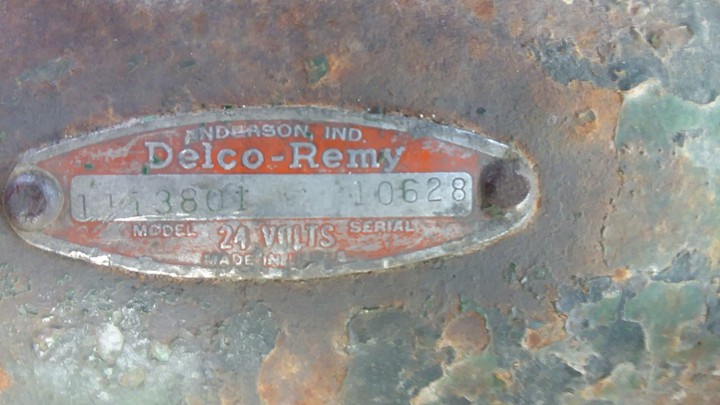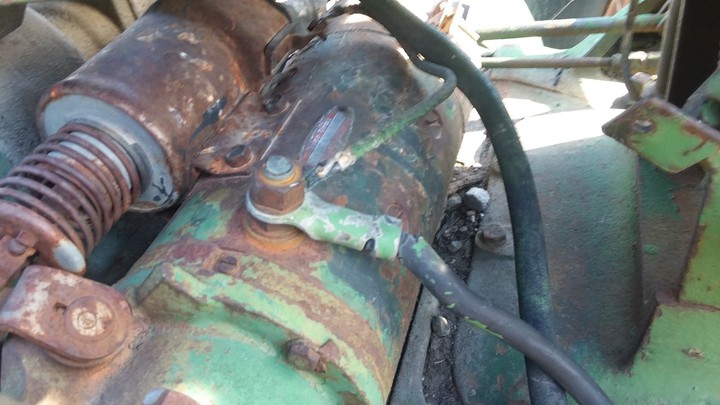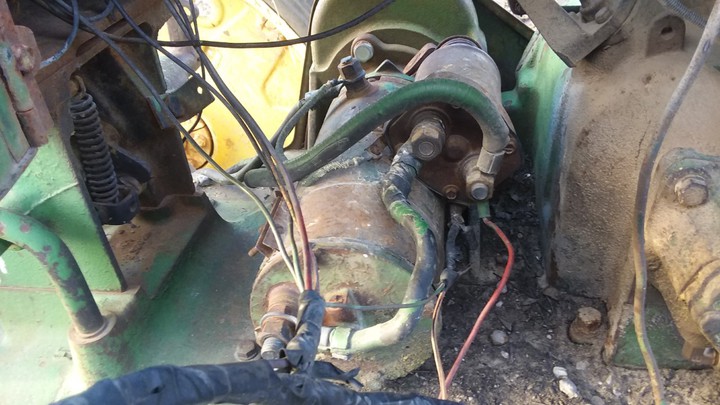Just began work on a John Deere 70 diesel that has been converted to 24 volt electric start. The tractor's big engine runs great, but has recently been started with a belt. Electric start wise everything is there and the conversion was done properly. I do not necessarily care for the electric start and will eventually look into making it pony start again in the future, but want to make sure the tractor is worthy of restoration first. Picture #1 is the manufactures tag on the starter. Picture #2 is from the flywheel side. Picture #3 is from the pulley side. Here are some questions I have:
1) I see there are two heavy insulated battery cables running from the starter to the battery box. One battery cable goes to the solenoid and one goes to the end of the starter. Does the positive go to the solenoid and the negative go to the end of the starter? Is that correct? How was it intended for the conversion to be hooked up? Two 12 volt batteries must be connected in series in the battery box - negative on the first battery to the positive on the second battery or vice versa? There were no batteries remaining in the battery box and no "jumper cable" for between the batteries when I bought it. So, just trying to wire it up correctly.
2) The battery box must not do any grounding? There are still a couple of short ground cables bolted to the box, but these may have been for the 6 volt starter when it was still pony start and were just not removed? Why didn't JD use the tractor body for the ground? Is the starter sort of isolated?
3) Is this starter used in other known applications?
4) Any other advice on the 24 volt conversion will be helpful. I know it isn't as powerful as the gas pony engine. I know batteries will have a hard time starting a 70 diesel when it is cold.
Thanks for the help.



1) I see there are two heavy insulated battery cables running from the starter to the battery box. One battery cable goes to the solenoid and one goes to the end of the starter. Does the positive go to the solenoid and the negative go to the end of the starter? Is that correct? How was it intended for the conversion to be hooked up? Two 12 volt batteries must be connected in series in the battery box - negative on the first battery to the positive on the second battery or vice versa? There were no batteries remaining in the battery box and no "jumper cable" for between the batteries when I bought it. So, just trying to wire it up correctly.
2) The battery box must not do any grounding? There are still a couple of short ground cables bolted to the box, but these may have been for the 6 volt starter when it was still pony start and were just not removed? Why didn't JD use the tractor body for the ground? Is the starter sort of isolated?
3) Is this starter used in other known applications?
4) Any other advice on the 24 volt conversion will be helpful. I know it isn't as powerful as the gas pony engine. I know batteries will have a hard time starting a 70 diesel when it is cold.
Thanks for the help.








